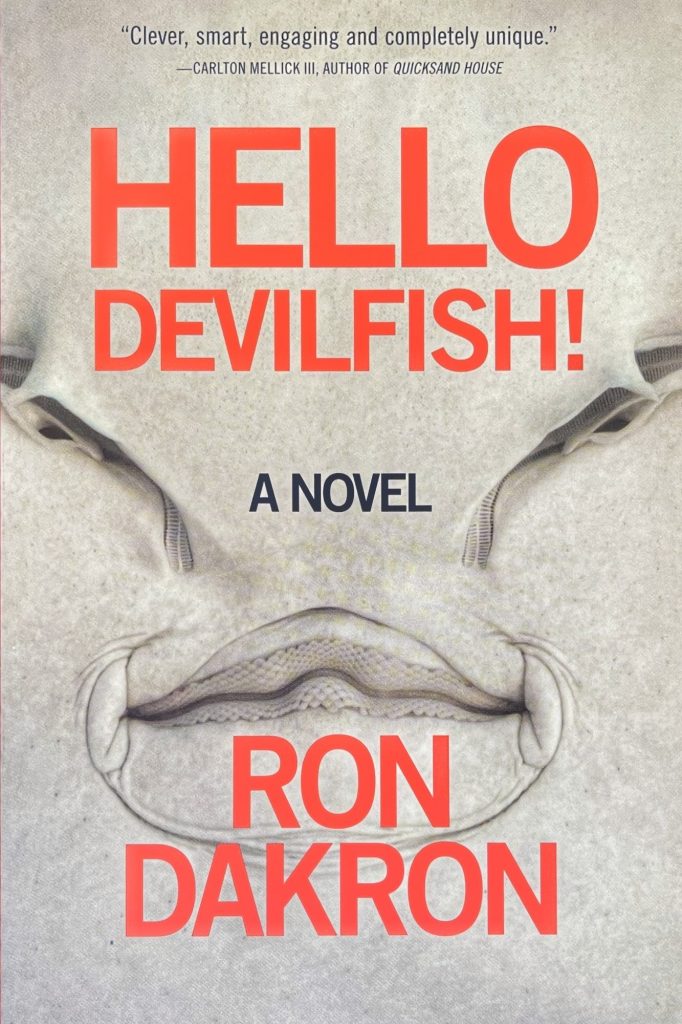2014 Book by Ron Dakron
Hello Devilfish!
Join our chocolate sugar orgasm!
Hello Devilfish! is a first-person (or first-fish) account of a giant blue Japanese movie monster stingray’s attack on contemporary Tokyo and his tragic morph into human form. Using elements of Japanese shock-pop and the infamous Hello Kitty meme, the story is told in comic narrative from the stingray’s point of view as he gleefully creams Tokyo into rubble. The stingray is soon pursued by Squidra, a love-struck giant squid. She demands love; he refuses. In an epic waterfront battle, she traps him in a human-growth hormone bath that changes him into a puny human — a reverse metamorphosis — monster to man. Refusing to accept his humanity, the stingray acts like his former giant self while trying to find food, shelter, romance — and avoid the destructive rampage of his stalker squid love interest.
Hello Devilfish! is told in a readable, comic narrative occasionally spiced with Manglish words. Funny and very readable, underneath the outlandish plot is a truly fresh critique of contemporary culture and mainstream literature.
Chapter 1 reading by Ron Dakron.

Reviews for Hello Devilfish!
The anarchist as social monster, scoffing at bourgeois values, is supersized into a 90-ft. “gigantor” blue stingray in this rapid-fire stomp through pop culture and Japanese monster movies. The titular creature, actually named Hello Devilfish! and also known as the “Marquis de Cod,” sprays napalm breath along with caustic commentary on the hapless residents of Tokyo while fleeing the unwanted affections of Squidra, a 100-ft. cuttlefish aiming to usurp his turf and his love. Seeking to destroy “Big Lit,” Hello Devilfish! proclaims his anti-book manifesto. Then an industrial accident shrinks him down into mere human form. Mistaken for a member of Blue Man Group, he wanders the Tokyo nightlife, sampling fast-food sea-slug sandwiches and cosplay bars, always dodging Squidra’s grasping tentacles. Dakron (HD Reviews) tosses out a stream of cultural criticisms warped as puns (“You gotta fight for your Reich to party”), even as he admits there’s no point in trying to upset our all-absorbing entertainment-industrial complex (“Nazi jokes are so 20th century”). Resistance may be futile, but this book at least makes it fun.

Staff
Publishers Weekly
The best way to read Hello Devilfish! is also the best way to watch a Japanese monster movie: all in one shot. Queue it up, pop some popcorn, sit back, relax, enjoy. I don’t know if Dakron intended it that way, but, at 148 pages, you’d be doing yourself a disservice if you read it any other way. Putting it down and coming back to it would be like pausing Godzilla in the middle and finishing it the next the afternoon. It just wouldn’t be the same experience.
Let’s not get this twisted, though. Hello Devilfish! isn’t some serious-faced monster story. It’s a comic romp that makes you laugh nearly as much as you shake your head and say, “What the fuck am I reading?” It’s a great feeling, a change-of-pace in a literary world with not nearly enough changes of pace. It’s like Monty Python acting out a Christopher Moore novel, or Christopher Moore writing a Monty Python sketch, or maybe it’s not like either of those things, and it probably isn’t because it’s one of the more unique stories I’ve read in recent memory and unlike anything you’ll read this year.
And that’s assuming Hello Devilfish! is only about what the blurb on the book jacket says it’s about. Yes, a giant stingray is eating Tokyo like its out to lunch at some trendy Ramen shop, and yes, he must evade the unwanted romantic advances of Squidra, a 100-foot long (tall?) squid, and yes, a freak accident turns that stingray into a weak, pathetic human being (which is where the story really begins to shine), but it’s more than that (it always is, right?).
Hello Devilfish! is also a scathing commentary on “Big Lit” and contemporary society, veiled in Manglish and monster movie tropes and hilarious turns-of-phrase (“It’s curious I even understand him—me talk Manglish, him talk Japanese. Hello Plot Flaw!”). It’s quite a bit of fun if you’re the absurd, open-minded type. And if you’re not that type, you’re the butt of the joke and the type who actually needs to read this book to understand why you’re responsible for the world’s current unstable state and its wholly uncertain future.

Ryan Peverly
LitReactor Bookshots
Ron Dakron channels Mark Leyner on speed with the manic intensity of David Tennant’s “Doctor Who” in this irresistibly funny, quite hilarious, Japanese monster science fiction film spoof of a novel that is also a not too sly fictional commentary on contemporary American mainstream literary fiction. Dakron slays literary snobbery and stands firmly in the excellent usage of speculative fiction as satire in his compellingly readable “first-fish” account as seen through the eyes of this devilish blue-tinted monstrous stingray as it attacks contemporary Tokyo before converting itself into something far more human. Quite possibly the funniest novel I have read in some time, “Hello Devilfish!” deserves a wide readership.

John Kwok
Amazon View Reviewer
“Plots are for babies and geezers.” If this novel by experimental writer Dakron (infra; Newt) has a mission statement, it’s that quote from the titular narrator. The story follows a Godzilla-esque monstrous manta ray that rises periodically to destroy Tokyo for kicks. During his latest rampage, the ray is attacked and pursued by a love-struck lady monster squid that wants to mate with him, which is an inconvenience to his city-destroying plans. Hello Devilfish! (as the monster is called) doesn’t just wreck Tokyo; he also tramples all over the fourth wall, detouring into several asides that rail against modern writing, classic literature, his own author, and the audience reading his book. To add to the disorientation, the story is told using Manglish, a language that approximates a bad Japanese-to-English translation.
VERDICT: For readers with a high tolerance of the unconventional, this is an audacious, laugh-out-loud novel that is brilliantly committed to its conceit. For more traditional readers, the kind despised by giant kaiju (monster) protagonists, it will be the literary equivalent of a headache. Recommended for fans of absurdist fiction authors such as Patrick Wensink and Carlton III Mellick.

Peter Petruski
Library Journal
Tokyo is burning, and Devilfish is laughing. He’s a kaiju, one of those fake-looking rubber monsters running amok—a giant blue manta ray, in this instance—and the very amusing narrator of Dakron’s Hello Devilfish! (Three Rooms Press, $15.95). Devilfish claims to be an enemy not just of Tokyo, where he gleefully topples power lines and elevated trains, munching on their passengers, but also of the novel itself. “Join us in plot-maiming fun!” he exclaims in Manglish, a comic lexicon made up of odd advertising slogans, poorly translated Japanese, LOL-speak, and I Can Has Cheezburger grammar. Destruction is this manta ray’s mantra. Yet the more his sting-tailed protagonist inveighs against Big Lit, local writer Dakron begins to sneak in some structure and literary mischief. Devilfish has an unwanted paramour in pursuit of him: another kaiju he calls Squidra, a giant pink kraken with tentacles and laser beams that shoot from her eyes. So there’s a bit of a love story in Hello Devilfish!, and a chase through the city’s smoldering rubble, an abrupt transformation (hello, Doug!), and flourishes of humor that recall Mark Leyner. Quoth the Devilfish, “I spit on realism and all its cunning henchmen!” Here’s a creature intending not to enter the literary canon but to destroy the library.

Brian Miller
Seattle Weekly
Sci-fi is a genre ripe for satire, and Ron Dakron is your man to provide it.

Dan Nailen
The Islander
An enormous stingray attacks Tokyo, is hunted by a lovelorn squid, and turns into a human being in Ron Dakron’s new novel, Hello Devilfish! Dakron is a local author by way of Chicago, and he’s been writing experimental science-fiction novels for years—Mantids involves mutant mantises and a Viagra overdose, Hammers is about a young geneticist whose DNA becomes combined with a hammerhead shark. How have you never heard of him before?

Paul Constant
The Stranger
One of the most unique books you’ll read this year—or ever. It brazenly sets out to tear down nearly every convention of mainstream literature. Hilariously absurd and full of comically warped puns, it begs to be read out loud.

